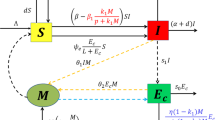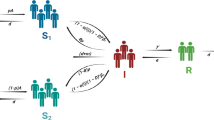Abstract
We propose and analyze a deterministic mathematical model for the transmission of food-borne diseases in a population consisting of humans and flies. We employ the Caputo operator to examine the impact of governmental actions and online food delivery services on the transmission of food-borne diseases. The proposed model investigates important aspects such as positivity, boundedness, disease-free equilibrium, basic reproduction number and sensitivity analysis. The existence and uniqueness of a solution for the initial value problem is established using Banach and Schauder type fixed point theorems. Functional techniques are employed to demonstrate the stability of the proposed model under the Hyers–Ulam condition. For an approximate solution, the iterative fractional order Predictor–Corrector scheme is utilized. The simulation of this scheme is conducted using Matlab as the numeric computing environment, with various fractional order values ranging from 0.75 to 1. Over time, all compartments demonstrate convergence and stability. The numerical simulations highlight the necessity for the government to implement the most effective food safety control interventions. These measures could involve food safety awareness and training campaigns targeting restaurant managers, staff members involved in online food delivery, as well as food delivery personnel.







Similar content being viewed by others
Availability of data and materials
The authors confirms that the data supporting the findings of this study are available within the article.
Code availability
Matlab code is available from the author on reasonable request.
References
Abidemi A (2023) Optimal cost-effective control of drug abuse by students: insight from mathematical modeling. Model Earth Syst Environ 9:811–829
Addai E, Zhang L, Asamoah JK, Essel JF (2023) A fractional order age-specific smoke epidemic model. Appl Math Model 119:99–118
Ahmed I, Baba IA, Yusuf A, Kumam P, Kumam W (2020) Analysis of Caputo fractional-order model for COVID-19 with lockdown. Adv Differ Equ 2020:394
Ahmad YU, Andrawus J, Ado A, Maigoro YA, Yusuf A, Althobaiti S, Mustapha UT (2024) Mathematical modeling and analysis of human-to-human monkeypox virus transmission with post-exposure vaccination. Model Earth Syst Environ 10:2711–2731
Ain QT, Anjum N, Din A, Zeb A, Djilali S, Khan ZA (2022) On the analysis of Caputo fractional order dynamics of middle east lungs coronavirus (MERS-CoV) model. Alex Eng J 61:5123–5131
Alade TO, Alnegga M, Olaniyi S, Abidemi A (2023) Mathematical modelling of within-host chikungunya virus dynamics with adaptive immune response. Model Earth Syst Environ 9:3837–3849
Aldila D, Götz T, Soewono E (2013) An optimal control problem arising from a dengue disease transmission model. Math Biosci 242:9–16
Alla Hamou A, Azroul E, Bouda S, Guedda M (2024) Mathematical modeling of HIV transmission in a heterosexual population: incorporating memory conservation. Model Earth Syst Environ 10:393–416
Anastassopoulou C, Russo L, Tsakris A, Siettos C (2020) Data-based analysis, modelling and forecasting of the COVID-19 outbreak. PLoS One 15:e0230405
Anderson RM, May RM (1991) Infectious diseases of humans: dynamics and control. Oxford University Press, Oxford
Asamoah JKK, Sun G-Q (2023) Fractional Caputo and sensitivity heat map for a gonorrhea transmission model in a sex structured population. Chaos Solitons Fractals 175:114026
Asamoah JKK, ** Z, Sun G-Q (2021a) Non-seasonal and seasonal relapse model for q fever disease with comprehensive cost-effectiveness analysis. Results Phys 22:103889
Asamoah JKK, ** Z, Sun G-Q, Seidu B, Yankson E, Abidemi A, Oduro F, Moore SE, Okyere E (2021b) Sensitivity assessment and optimal economic evaluation of a new COVID-19 compartmental epidemic model with control interventions. Chaos Solitons Fractals 146:110885
Aslam M, Murtaza R, Abdeljawad T, Rahman GU, Khan A, Khan H, Gulzar H (2021) A fractional order HIV/AIDS epidemic model with Mittag-Leffler kernel. Adv Differ Equ 2021:1–15
Ball FG, Knock ES, O’Neill PD (2008) Control of emerging infectious diseases using responsive imperfect vaccination and isolation. Math Biosci 216:100–113
Barro M, Guiro A, Ouedraogo D (2018) Optimal control of a sir epidemic model with general incidence function and a time delays. Cubo (Temuco) 20:53–66
Becker N (1979) The uses of epidemic models. Biometrics 35(1):295–305
Brauer F, Castillo-Chavez C, Castillo-Chavez C (2012) Mathematical models in population biology and epidemiology, vol 2. Springer, Berlin
Caputo M, Fabrizio M (2015) A new definition of fractional derivative without singular kernel. Prog Fract Differ Appl 1:73–85
Casella F (2020) Can the COVID-19 epidemic be controlled on the basis of daily test reports? IEEE Control Syst Lett 5:1079–1084
Castilho C (2006) Optimal control of an epidemic through educational campaigns. Electron J Differ Equ 2006(125):1–11
DiCicco K, Noor NB, Yousefi N, Maleki M, Spann B, Agarwal N (2020) Toxicity and networks of COVID-19 discourse communities: a tale of two social media platforms. In: Proceedings. http://ceur-ws.org. ISSN:1613-0073
Diethelm K (2013) A fractional calculus based model for the simulation of an outbreak of dengue fever. Nonlinear Dyn 71:613–619
Diethelm K, Ford NJ, Freed AD (2004) Detailed error analysis for a fractional Adams method. Numer Algorithms 36:31–52
Djordjevic J, Silva CJ, Torres DF (2018) A stochastic SICA epidemic model for HIV transmission. Appl Math Lett 84:168–175
Ebenezer B, Asamoah JKK, Khan I, Kwesi A-AS, Khan MA (2017) The multi-step homotopy analysis method for a modified epidemiological model for measles disease. Nonlinear Sci Lett A 8:320–332
Giles-Corti B, Vernez-Moudon A, Reis R et al (2016) City planning and population health: a global challenge. Lancet 388:2912–2924
González-Parra G, Arenas AJ, Chen-Charpentier BM (2014) A fractional order epidemic model for the simulation of outbreaks of influenza A (H1N1). Math Methods Appl Sci 37:2218–2226
Khan MA, Hammouch Z, Baleanu D (2019) Modeling the dynamics of hepatitis E via the Caputo–Fabrizio derivative. Math Model Nat Phenom 14:311
Kumar S, Chauhan R, Momani S, Hadid S (2024) Numerical investigations on COVID-19 model through singular and non-singular fractional operators. Numer Methods Partial Differ Equ 40:e22707
Mugabi, F, Duffy KJ, van Langevelde F (2024) Behaviours of honeybees can reduce the probability of deformed wing virus outbreaks in varroa destructor-infested colonies. Model Earth Syst Environ. https://doi.org/10.1007/s40808-024-01974-9
Mustapha UT, Qureshi S, Yusuf A, Hincal E (2020) Fractional modeling for the spread of hookworm infection under Caputo operator. Chaos Solitons Fractals 137:109878
Ndaïrou F, Area I, Nieto JJ, Silva CJ, Torres DF (2018) Mathematical modeling of Zika disease in pregnant women and newborns with microcephaly in Brazil. Math Methods Appl Sci 41:8929–8941
Ndaïrou F, Area I, Nieto JJ, Torres DF (2020) Mathematical modeling of COVID-19 transmission dynamics with a case study of Wuhan. Chaos Solitons Fractals 135:109846
Noor NB, Yousefi N, Spann B, Agarwal N (2023) Comparing toxicity across social media platforms for COVID-19 discourse. Preprint
Peter OJ, Kumar S, Kumari N, Oguntolu FA, Oshinubi K, Musa R (2022a) Transmission dynamics of Monkeypox virus: a mathematical modelling approach. Model Earth Syst Environ 8(3):3423–3434
Peter OJ, Oguntolu FA, Ojo MM, Olayinka Oyeniyi A, Jan R, Khan I (2022b) Fractional order mathematical model of monkeypox transmission dynamics. Phys Scr 97:084005
Podlubny I (1998) Fractional differential equations: an introduction to fractional derivatives, fractional differential equations, to methods of their solution and some of their applications. Elsevier, Amsterdam
Rachah A, Torres DF (2016) Dynamics and optimal control of Ebola transmission. Math Comput Sci 10:331–342
Sahu I, Jena SR (2023) SDIQR mathematical modelling for COVID-19 of Odisha associated with influx of migrants based on Laplace Adomian decomposition technique. Model Earth Syst Environ 9:4031–4040
Shaik M, Yousefi N, Agarwal N, Spann B (2023) Evaluating role of Instagram’s multimedia in connective action leveraging diffusion of innovation and cognitive mobilization theories: Brazilian and Peruvian social unrest case studies. In: 2023 10th International conference on behavioural and social computing (BESC). IEEE, pp 1–6
Sharma AK, Kumar V, Singh RN (2023) A fractional treatment to food-borne disease modeling by q-homotopy analysis transform method (q-HATM). Int J Adv Res Sci Commun Technol 3(1):508–523
Sher M, Shah K, Khan ZA, Khan H, Khan A (2020) Computational and theoretical modeling of the transmission dynamics of novel COVID-19 under Mittag-Leffler power law. Alex Eng J 59:3133–3147
Statista (2021) Online food delivery. https://www.statista.com/outlook/dmo/eservices/online-food-delivery/australia
Strategy A (2021) Making delivery work for everyone. https://www.readkong.com/page/making-delivery-work-for-everyone-march-2021-accenture-8593927
Thabet ST, Abdo MS, Shah K, Abdeljawad T (2020) Study of transmission dynamics of COVID-19 mathematical model under ABC fractional order derivative. Results Phys 19:103507
Tilahun GT, Woldegerima WA, Mohammed N (2021) A fractional order model for the transmission dynamics of hepatitis B virus with two-age structure in the presence of vaccination. Arab J Basic Appl Sci 28:87–106
UNTW (2022) The 2030 agenda for sustainable development: United Nations. https://sdgs.un.org/ 2030agenda
Yousefi N (2021) Exploring machine learning methods for predicting disease progression in colon cancer patients
Yousefi, N, Noor NB, Spann B, Agarwal N (2023) Towards develo** a measure to assess contagiousness of toxic tweets. In: Proceedings of the international workshop on combating health misinformation for social wellbeing
Zhang L, Addai E, Ackora-Prah J, Arthur YD, Asamoah JKK et al (2022) Fractional-order Ebola-Malaria coinfection model with a focus on detection and treatment rate. Comput Math Methods Med 2022:6502598
Acknowledgements
This work was partially supported by the Fundação para a Ciência e a Tecnologia, I.P. (FCT, Funder ID = 50110000187) under Grants UIDB/04106/2020 and UIDP/04106/2020 (CIDMA); and Project 2022.03091.PTDC (CoSysM3).
Author information
Authors and Affiliations
Contributions
The authors confirms sole responsibility for study conceptualization, methodology, formal analysis, codes writing, manuscript writing and editing, and approval of the final manuscript draft.
Corresponding author
Ethics declarations
Conflict of interest
The authors has no Conflict of interest to declare that are relevant to the content of this article.
Additional information
Publisher's Note
Springer Nature remains neutral with regard to jurisdictional claims in published maps and institutional affiliations.
Rights and permissions
Springer Nature or its licensor (e.g. a society or other partner) holds exclusive rights to this article under a publishing agreement with the author(s) or other rightsholder(s); author self-archiving of the accepted manuscript version of this article is solely governed by the terms of such publishing agreement and applicable law.
About this article
Cite this article
Addai, E., Torres, D.F.M., Abdul-Hamid, Z. et al. Modelling the dynamics of online food delivery services on the spread of food-borne diseases. Model. Earth Syst. Environ. (2024). https://doi.org/10.1007/s40808-024-02046-8
Received:
Accepted:
Published:
DOI: https://doi.org/10.1007/s40808-024-02046-8
Keywords
- Mathematical modelling
- Food-borne diseases transmission
- Online food delivery
- Caputo fractional derivatives
- Numerical simulations




